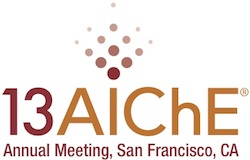

Reactant Conversion and Product Speciation of Carbohydrate Model-Compound Pyrolysis Using a Novel Flow ReactorPatrick J. Fahey , Vikram Seshadri , Xinglian Geng , and Phillip R. Westmoreland* North Carolina State University , Raleigh , NC 27695 The model compounds 1 ,2-propanediol , 1 ,3-propanediol , 1 ,2 ,3-propanetriol , hydroxypropanone , and acetaldehyde diethyl acetal were pyrolyzed neat and as methanol solutions in a pulse-injected tube-furnace reactor. Reaction products were analyzed directly by comprehensive , two-dimensional gas chromatography time-of-flight mass spectrometry (GCxGC-TOFMS). For example , pyrolysis of 1 ,3-propanediol at 500°C produced 90 identified peaks. We experimented with molecules smaller than glucose to understand better the pyrolysis reaction networks of glucose-based carbohydrates. Cellulose has a complicated pyrolysis reaction network that researchers have tried to understand through experimenting with monosaccharide , disaccharide , and small-oligosaccharide pyrolyses.1 ,2 Here , using molecules smaller than glucose provided two benefits not possible with using entire monomers or dimers. First , smaller molecules isolate specific sequences of functional groups , which reduces the number of possible side reactions and products. Thus , smaller molecules simplified the chemical analysis of the reaction-product mixture and the construction of reaction pathways.3 Second , smaller molecules allow computational-quantum-chemistry simulations to execute faster with the same level of theory. Thus , smaller molecules allow deeper analyses of the specific reaction mechanisms in their hypothesized pyrolysis reaction networks.4References Pushkaraj R. Patwardhhan , Justinus A. Satrio , Robert C. Brown , Brent H. Shanks , “Product distribution from fast pyrolysis of glucose-based carbohydrates ,” Journal of Analytical and Applied Pyrolysis , 86 (2009) 323-330. Edward B. Sanders , Alan I. Goldsmith , Jeffrey I. Seeman , “A model that distinguishes the pyrolysis of D-glucose , D-fructose , and sucrose from that of cellulose. Application to the understanding of cigarette smoke formation ,” Journal of Analytical and Applied Pyrolysis 66 (2003) 29-50. John B. Paine III , Yezdi B. Pithawalla , John D. Naworal , Charles E. Thomas Jr. “Carbohydrate pyrolysis mechanisms from isotopic labeling Part 1. The pyrolysis of glycerin: Discovery of competing fragmentation mechanisms affording acetaldehyde and formaldehyde and the implications for carbohydrate pyrolysis ,” Journal of Analytical and Applied Pyrolysis 80 (2007) 297-311. Vikram Seshadri and Phillip R. Westmoreland , “Concerted reactions and mechanism of glucose pyrolysis and implications for cellulose kinetics ,” Journal of Physical Chemistry A , 116 (2012) 11997-12013. Contact InformationPatrick J. Fahey pjfahey@ncsu.eduDepartment of Chemical & Biomolecular Engineering North Carolina State University Box 7905 Raleigh , NC 27695-7905 Vikram Seshadri vseshad@ncsu.eduDepartment of Chemical & Biomolecular Engineering North Carolina State University Box 7905 Raleigh , NC 27695-7905 Xinglian Geng xgeng@ncsu.eduDepartment of Chemical & Biomolecular Engineering North Carolina State University Box 7905 Raleigh , NC 27695-7905 Phillip R. Westmoreland* prwestmo@ncsu.eduProfessor , Department of Chemical & Biomolecular Engineering Executive Director , Institute for Computational Science and Engineering North Carolina State University Box 7905 Raleigh , NC 27695-7905 *To whom correspondence should be addressed.
